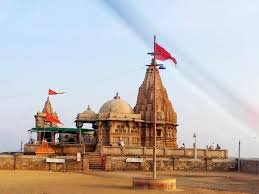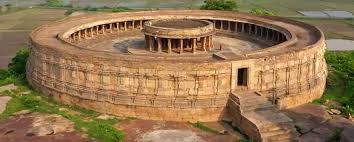The Ranakpur Jain Temple, located in the serene Aravalli hills of Rajasthan, is an architectural marvel and a significant pilgrimage site for Jain devotees. Built in the 15th century, this temple is dedicated to Lord Adinath, the first Tirthankara of Jainism. With its intricate marble carvings, stunning architecture, and spiritual ambiance, the temple continues to captivate visitors from around the world.
Beyond its architectural splendor, the Ranakpur Jain Temple holds immense religious and cultural significance. Every pillar, dome, and carving tells a story of devotion and artistry, making it a must-visit destination for spiritual seekers and history enthusiasts alike.
A Glimpse into History
The history of Ranakpur Jain Temple dates back to the 15th century when a wealthy Jain merchant, Dharna Shah, envisioned a grand temple dedicated to Lord Adinath. Inspired by a divine vision, he sought the support of Rana Kumbha, the ruler of Mewar, who graciously provided land for the temple’s construction.
Under the guidance of sculptor Depa, the temple took shape over several decades, with thousands of artisans meticulously carving its intricate details. Today, it stands as a testament to the artistic brilliance and deep devotion of the Jain community.
A Marvel of 1,444 Pillars
One of the most fascinating aspects of this temple is its 1,444 intricately carved marble pillars. Each pillar is unique, featuring exquisite designs and patterns. Interestingly, no two pillars are alike, reflecting the craftsmanship and dedication of ancient artisans.
Stunning Domes and Ceilings
The temple’s ceilings are adorned with intricate floral patterns, geometric designs, and celestial figures, leaving visitors in awe of their artistic brilliance. Additionally, the beautifully sculpted domes enhance the grandeur of the temple, making it a true masterpiece of medieval Indian architecture.
Four-Faced (Chaturmukha) Design
Ranakpur Jain Temple follows a Chaturmukha (four-faced) design, symbolizing the fourfold path of Jainism—right faith, right knowledge, right conduct, and right austerity. This unique layout allows devotees to enter the temple from all four directions, reinforcing the idea of universal accessibility to divine knowledge and enlightenment.
Spiritual Significance and Rituals
Beyond its architectural beauty, Ranakpur Jain Temple is a sacred place of worship and meditation. The temple embodies the principles of Jainism, emphasizing non-violence, truth, and self-discipline.
A Pilgrimage of Peace and Purity
Many Jain devotees consider visiting Ranakpur a deeply purifying experience. Moreover, the temple’s tranquil surroundings, combined with its divine atmosphere, offer a perfect setting for meditation and spiritual reflection. As a result, visitors often find solace and inner peace in the temple’s serene ambiance, making it a cherished destination for those seeking spiritual rejuvenation.
The Role of Donations in Temple Preservation
Over the centuries, donations from devotees and patrons have played a crucial role in maintaining and restoring the temple. Contributions help with:
- Preservation of intricate carvings and sculptures, ensuring that the temple’s artistic beauty remains intact.
- Organizing religious festivals and cultural events that spread Jain teachings and traditions.
- Improving infrastructure and facilities for visitors, making their pilgrimage experience more comfortable.
Devotees can contribute through monetary donations, offering seva (selfless service), or sponsoring rituals and prayers. Every contribution helps sustain the temple’s legacy for future generations.
Festivals Celebrated at Ranakpur Jain Temple
Throughout the year, the Ranakpur Jain Temple hosts several religious festivals, drawing thousands of pilgrims. Some of the most important celebrations include:
Mahavir Jayanti
This festival marks the birth anniversary of Lord Mahavir, the 24th Tirthankara of Jainism. The temple comes alive with prayers, processions, and discourses, celebrating his teachings of non-violence and truth.
Diwali and New Year Celebrations
Unlike Hindu traditions, Jains celebrate Diwali as the day Lord Mahavir attained nirvana (liberation). The temple is illuminated with lamps, and devotees participate in prayers and meditation.
How to Reach Ranakpur Jain Temple
Located in Ranakpur village, near Udaipur, the temple is well-connected by road, rail, and air.
- Regular buses and taxis operate from Udaipur, Jodhpur, and Mount Abu, making it easily accessible.
- The nearest railway station is Falna (35 km away), which connects major cities in Rajasthan.
- The closest airport is Maharana Pratap Airport in Udaipur (90 km away). From there, visitors can hire a taxi to reach the temple.
Visitor Guidelines and Temple Timings
To ensure a peaceful and respectful experience, visitors should follow certain guidelines:
- Temple Timings: Open from 7:00 AM to 7:00 PM.
- Dress Code: Modest and traditional attire is recommended.
- Photography: Not allowed inside the temple premises to maintain its sanctity.
- Respect Jain Traditions: Avoid carrying leather items or consuming food inside the temple.
Conclusion
The Ranakpur Jain Temple stands as a remarkable symbol of devotion, artistry, and spirituality. Moreover, its exquisite architecture, profound religious significance, and serene atmosphere make it one of the most cherished Jain temples in India. Furthermore, the temple’s intricate carvings and grand structure continue to captivate devotees and travelers alike, offering an experience that is both spiritually uplifting and culturally enriching.
Whether you are a devotee seeking divine blessings, a history enthusiast admiring medieval architecture, or a traveler exploring Rajasthan’s rich heritage, a visit to this magnificent temple promises an unforgettable spiritual experience.





